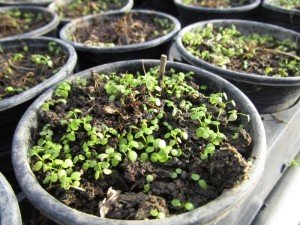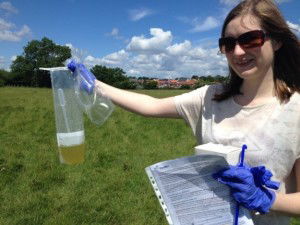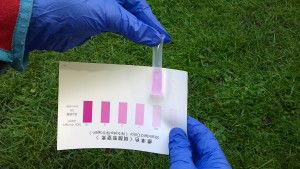The first year of People, Ponds and Water
28th January 2016
People, Ponds and Water has been running for a whole year now. Here’s a flavour of what we’ve achieved so far in the three parts of the project: Flagship Ponds, PondNet, and Clean Water for Wildlife
Flagship Ponds
We’ve produced guidance information for Flagship Pond community groups, including summary information on each of the Flagship Pond sites. We are currently engaged with 36 groups to develop long term management plans for the ponds. We plan to engage with the remaining sites this year, to make sure there is enough time for management or monitoring work before the end of the project.
At some Flagship Sites, there are established volunteer groups and we are working with them to provide training to up-skill their members to survey for rare species which were previously unrecorded. At other sites, we are beginning the process of developing groups. Some of the highlights of the work so far have been:
 Adder’s-tongue Spearwort seedlings, destined for reintroduction to Inglestone Commonex-situ work with the Millennium Seed Bank, Kew to rear hundreds of seedlings of the rare Adder’s-tongue Spearwort for reintroduction in to Inglestone Common, one of only two known sites for this plant in the country;
Adder’s-tongue Spearwort seedlings, destined for reintroduction to Inglestone Commonex-situ work with the Millennium Seed Bank, Kew to rear hundreds of seedlings of the rare Adder’s-tongue Spearwort for reintroduction in to Inglestone Common, one of only two known sites for this plant in the country;- creation of new pond habitat for water vole and tubular-water dropwort at Rawcliffe Meadows in York;
- the discovery of a new sites for one of our rarest freshwater species, the white-clawed crayfish, by Flagship Pond volunteers during a Flagship event on the Begwyns;
- finding a volunteer who is keen to create a photographic history exhibition of the ponds on Cock’s Marsh, revealing the connection between people and the ponds now and in the past.
In total, we have had trained over 30 volunteers to undertake survey and monitoring for restricted species on Flagship sites, and 60 more have agreed to undertake other activities at Flagship sites, such as practical management, testing water chemistry, helping to prepare the management plans or run activity days. We have also had species and site management advice from 7 species experts who have given their time freely to the project.
PondNet
PondNet has been rolled out to 17 counties in England and Wales, and more volunteers engagement across England to survey for Great Crested Newts using novel eDNA techniques. The eDNA project has produced some of the first scientifically credible data on the distribution and status of Great Crested Newts at a national level, and was only possible because of the commitment and willingness of PondNet volunteers.
 Collecting water samples to be analysed for Great Crested Newt eDNA
Collecting water samples to be analysed for Great Crested Newt eDNA
During the autumn, volunteers have been finishing surveys for restricted species and submitting their records. In total, we have surveyed a whopping 620 ponds using PondNet volunteers. This was nearly double our target by this stage of the project. Surveys were undertaken by 313 volunteers, the majority of which were undertaking surveys where no previous experience was required.
We ran 65 training sessions and had support from 5 experts who, wonderfully, volunteered time to mentor PondNetters outside of the formal training sessions. Our plan this year is to offer introductory training sessions to a wider audience, for volunteers who want to try out a new type of survey, such as invertebrates or plants.
Our regional officers have now begun to agree sites and landowner permissions for the rapidly approaching 2016 survey season. Thanks to funding from Natural England, local environmental record centres have been able to provide us with site, species and landowner information. Volunteers will be able to adopt sites for survey through the WaterNet data hub from the beginning of March.
Clean Water for Wildlife
With help from a parish council, a community group, National Trust members, volunteers in the New Forest National Park, and school and college students, we developed the concept and materials for the Clean Water for Wildlife survey, making sure it was simple, clear and effective. The guidance, and how to get involved, is now published on our website.
 Using a Clean Water for Wildlife test kit is simple
Using a Clean Water for Wildlife test kit is simple
As part of this process, 41 volunteers collected water samples and provided feedback on the use of the water testing kits. They helped to develop the printed instructions and interpretation material, and gave us an insight into how they might use the water quality data in local plans, pond management plans, or to raise awareness of nutrient pollution.
We are now beginning to develop plans for the first national survey in 2016. So far, around 30 volunteer groups have begun to register their interest in taking part in the survey in March. This includes, members of the Women’s Institute, local wildlife groups, education centres, schools and catchment groups.
Thank you
Thanks to the support of the Heritage Lottery Fund, and everyone who has contributed time and effort to People, Ponds and Water, we are making a real difference for freshwater wildlife. Here’s to the next year!
Want to know more?
- Go to the Flagship Pond, PondNet or Clean water for Wildlife webpages
- Email peoplepondswater@freshwaterhabitats.org.uk to sign up for a survey
- Read more about the results of the 2015 eDNA survey and the development of the eDNA methodology
- Find out how you can get involved in the Thames Water for Wildlife survey
- Get news and updates on our PondNet Facebook page
- Join our mailing list to get our newsletter and more
